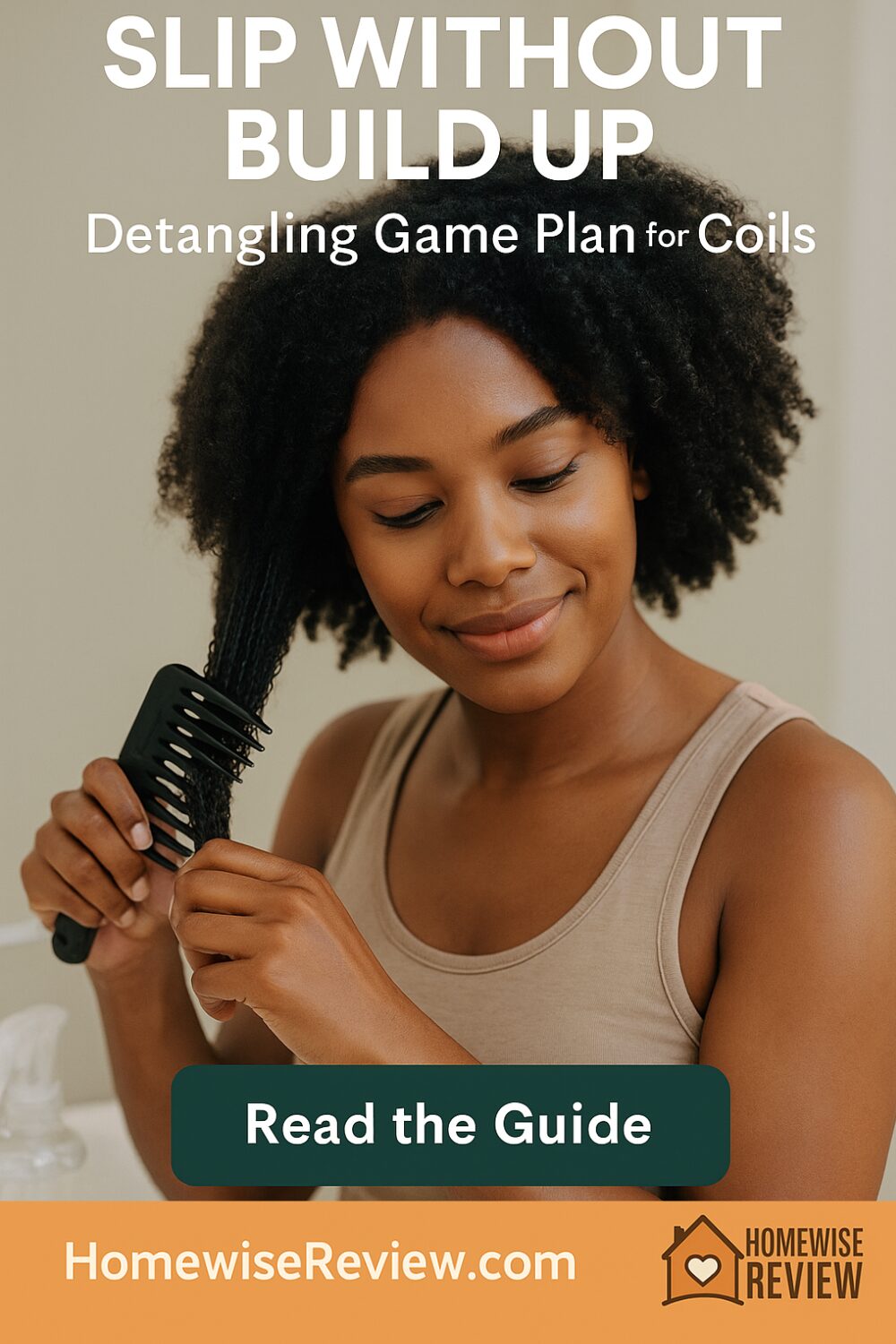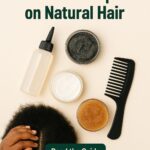
Smooth knots out fast, keep definition, skip the gunk.
Coils love slip, but heavy products can stack up and dull everything. This game plan gives you a step-by-step detangling routine that adds glide where you need it and rinses clean where you don’t. Expect fewer snags, less breakage, and coils that spring back.
What you’ll need
- Wide-tooth comb or detangling brush made for tight curls
- Sectioning clips
- Spray bottle with warm water
- Lightweight conditioner with great slip
- Optional pre-poo oil or conditioner
- T-shirt or microfiber towel
Steps
- Prep with just enough slip
- Mist dry sections with warm water. Work a quarter-size amount of lightweight conditioner or a few drops of pre-poo oil through the ends.
- Focus on the oldest hair first, which is your ends. That is where knots live.
- Why it matters: hydration plus a small amount of lubricant lowers friction so strands slide past each other.
- Section small to win big
- Split hair into 4 to 8 sections. Clip each one.
- Work one section at a time. Keep other sections twisted so they do not re-tangle.
- Why it matters: smaller sections mean less tugging and fewer ripped strands.
- Finger detangle first
- Start at the ends and pull apart big knots with your fingers.
- If a knot will not budge, add one more pump of conditioner, then try again.
- Why it matters: fingers feel knots better than tools and prevent the brush from forcing a tight tangle up the strand.
- Tool pass from ends to roots
- Use a wide-tooth comb or detangling brush. Begin at the last inch of hair, then move up in short passes.
- Keep tension gentle. If the tool catches, stop and re-wet.
- Why it matters: short, patient strokes reduce mechanical damage and single-strand knots.
- Add slip smart, not heavy
- Use a conditioner that spreads easily and rinses clean. If you need more glide, add a pea-size at a time.
- Aim to see strands separated and glossy, not coated.
- Why it matters: too much product mixes with shed hair and creates gummy tangles later.
- Rinse strategy for bounce
- Rinse thoroughly at the scalp and mid-lengths. If your ends love extra slip, leave a whisper of conditioner on the last inch.
- Low porosity tip: rinse fully, then apply a light leave-in on damp hair so it sits on top without building up.
- High porosity tip: keep a touch of conditioner on ends, then layer a light sealant.
- Set the pattern while hair is wet
- Twist or braid each detangled section before moving on.
- Blot with a T-shirt, never rough towel dry.
- Style as usual with a light leave-in and a gel that dries clean.
When to reach for this
- Low porosity coils: prefer warm water, light conditioner, complete rinse at roots, tiny leave-in on ends.
- High porosity coils: benefit from richer slip on ends and a light seal afterward.
- Post-protective style takedown: add extra finger-detangling time and patience.
- Weekly wash day: follow all steps. For midweek refresh, use steps 1, 2, and 7 only.
Product picks (4)
1) Lightweight Slip Conditioner
Why it works: Gives glide from cationic conditioners that smooth the cuticle without waxy residue.
How to use: Work through small sections, detangle, then rinse well at the scalp.
Keep in mind: If hair feels squeaky, you rinsed too aggressively on the ends.
Who it’s for: Tight coils that get greasy easily or live in humid climates.
2) Detangling Brush for Coils
Why it works: Flexible rows move with curls instead of ripping through them.
How to use: Always start at the last inch of hair and move up in short passes.
Keep in mind: Clean shed hair from the brush as you go to avoid new snags.
Who it’s for: Medium to high density coils that need consistent tension.
3) Pre-Poo Oil or Conditioner
Why it works: Reduces friction on dry tangles and protects during cleansing.
How to use: Apply a few drops or a dime-size of conditioner to ends, wait 5–10 minutes, then detangle.
Keep in mind: More is not better. Excess makes rinsing harder.
Who it’s for: Coils with older, weathered ends or frequent single-strand knots.
4) Lightweight Leave-In
Why it works: Adds slip for styling without a heavy film that attracts lint and dust.
How to use: A nickel-size per quadrant on soaking wet hair, then style.
Keep in mind: If hair feels coated on day two, halve the amount next time.
Who it’s for: Anyone who wants soft definition and easy refresh days.
Quick fixes vs long-term habits
- Quick fix: Mist with warm water and add a pea-size of conditioner to stubborn knots before brushing.
- Long-term: Trim dusting every 8–12 weeks, small sections every wash day, and a light-handed product routine.
Final Thoughts
Detangling coils should feel smooth, not stressful. The winning formula is warm water, patient sections, finger work first, and lightweight products used sparingly. Keep slip where it helps the most and rinse clean where buildup hurts the most. Your coils will thank you with bounce and shine.
See also
If you need a shopping shortlist to keep this routine simple, see Best Products for Natural Hair for lightweight conditioners, leave-ins, and tools curated for textured hair. Pair that with Best Brushes for 4C Hair Detangling and Stretching to pick a brush that will not fight your pattern.
For wash-day flow, check Wash Day Routine for 4C Hair Step by Step to plug this detangling into a full routine. If you suspect residue, Chelating vs Clarifying Shampoo: What Each Does and When to Use can help you reset without stripping. To keep definition clean after styling, Product Layering to Avoid Flakes on 4C Hair shows the right order and amounts that prevent gunk.
FAQs
1) Is silicone always bad for coils?
No. Some silicones add great slip and rinse clean. If hair feels coated, reduce the amount or switch to lighter options.
2) How often should I detangle?
Once per wash day is enough for most. Add a mini refresh midweek only if you are dealing with sweat, wind, or an upcoming restyle.
3) Can I detangle dry?
Not recommended. Always add water and a bit of slip to lower friction and prevent breakage.
4) Why do I get knots again the next day?
Usually section size was too big, ends need a trim, or you used too much product. Try smaller sections and lighter amounts.
5) What if my scalp gets itchy after I add more conditioner for slip?
Rinse the scalp area thoroughly and keep extra slip on the ends only. If itch continues, simplify the routine and patch test products.
Affiliate Disclosure
If you purchase through links on our site, we may earn a small commission at no extra cost to you.




